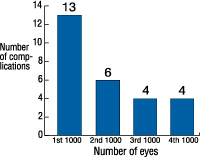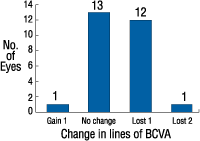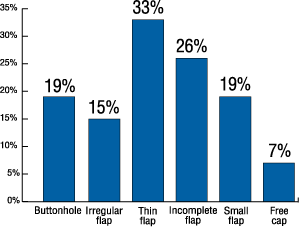Knowing microkeratome complications rate would help surgeons select new devices
Surgeons often turn to more experienced colleagues for advice about which microkeratome to buy.
LOS ANGELES — With all the attention being focused on medical complications, refractive surgeons have begun to scrutinize the one that affects them the most — microkeratome complications.
Surgeons are buying newer microkeratomes in an effort to diminish their complications for LASIK. Flap complications are rare, and a loss in visual acuity as a result is even more rare.
However, little hard data exists about which microkeratome is the safest, said Robert K. Maloney, MD, of the Maloney Eye Institute.
“One of the biggest problems of the microkeratome buyer is figuring out which one is the safest,” Dr. Maloney told Ocular Surgery News. “We’d like to know what the rates of complications are in experienced hands.”
However, complication rates are often underreported by surgeons, so manufacturers and regulatory agencies may not be able to provide the correct evaluations, he said. Often, surgeons turn to their more experienced colleagues and ask for advice.
Reporting method
|
Only surgeons with a huge series of cases will accumulate enough data to conclude what the true complications rate is of a device, so Dr. Maloney records any microkeratome complication in his operative log. This allows him to calculate the time and number of cases between complications and gain a true understanding of the complications rate of his microkeratome.
“This system would be useful if high-volume surgeons would use it,” he said. “It would give people a better idea of what complication rates are.”
The system helped Dr. Maloney evaluate the fluctuations in his own complication rates when he switched from the Automated Corneal Shaper (ACS; Bausch & Lomb Surgical, Claremont, U.S.A.) to the Hansatome (Bausch & Lomb Surgical). He followed his complications rate as it started at one in 250 eyes with the ACS, rose slightly as he passed a learning curve with the Hansatome and then fell to one in 2,500 cases.
“Between eye 12,000 and eye 17,500, our complications rate dropped to one in 2,500, which is now 0.04%,” Dr. Maloney said. “That’s a confluence of two things. I’m getting better at LASIK, and I’ve switched to the Hansatome, which is a safer microkeratome.”
Learning curve
|
To quantify the complications rate of the microkeratome, Dr. Maloney and Vivien M-B. Tham, BSc, MBBS, of the Jules Stein Eye Institute in Los Angeles, evaluated the incidence and outcomes of microkeratome complications in a retrospective, noncomparative case series of 3,998 eyes that underwent primary LASIK by four surgeons between November 1996 and August 1998. Researchers found and reviewed all cases with significant microkeratome complications that forced the surgeon to abandon the LASIK procedure.
They reported their results in the April issue of Ophthalmology.
In the series, 27 complications prevented the LASIK procedure. The overall rate of microkeratome complications was one in 150 (0.68%).
However, a learning curve presented itself. Dr. Maloney reported in Ophthalmology that while one in 77 (1.3%) complications occurred in the surgeons’ first 1,000 eyes, this rate decreased to one in 250 (0.4%) between eyes 3,000 and 4,000. Of the 24 planned bilateral cases, 15 complications (63%) occurred on the first operated eye, suggesting a problem with the blade or the microkeratome setup. Also, 26 of 27 eyes (96%) recovered to within one line of preoperative best corrected visual acuity (BCVA), while only one eye lost two lines.
Low complications rate
|
Of the eyes with microkeratome complications, three of 27 eyes (11%) experienced epithelial ingrowth that required follow-up treatment. Four of 27 eyes (15%) required repositioning to correct partially dislocated flaps or visually significant folds. Another 16 eyes (59%) underwent a second LASIK procedure.
In these 16 eyes, surgeons made a new flap and attempted LASIK. Two of the 16 had complications and one of the two was abandoned because of a thin flap. The other eye had a free cap and underwent surgery. All 16 eyes recovered to within one line of preoperative BCVA.
Of the 27 eyes, only one lost two lines of BCVA, Dr. Maloney reported in his study.
Dr. Maloney had one eye of 3,998 lose two lines of BCVA. The key for his low complications rate is to not continue cases in which there has been a microkeratome complication, he said. Once a complication has occurred, surgeons should replace the flap and stop the case.
“If laser treatment is done, we’ve seen a number of disasters,” he said. “The key piece of information for microkeratome complications from that study is if you have a problem, don’t do a laser treatment.”
For Your Information:Reference
- Robert K. Maloney, MD, can be reached at the Maloney Vision Institute, 10921 Wilshire Blvd., Ste. 900, Los Angeles, CA 90024 U.S.A.; +(1) 310-208-3937; fax: +(1) 310-208-8058.
- Bausch & Lomb Surgical can be reached at The Enterprise Center, Easthampton Road, Bracknell, Berks RG12 1NF England; +(44) 1-344-30-03-30; fax +(44) 1-344-45-45-58.
- Tham VMB, Maloney RK. Microkeratome complications of laser in situ keratomileusis. Ophthalmology. 2000;107:920-924.



